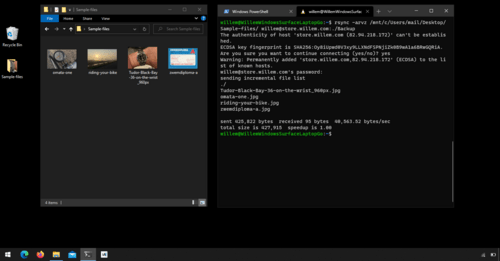
The / modifier used after original instructs rsync to copy the contents of the original directory to the duplicate folder. The -r ( –recursive) option tells rsync to copy everything, including subdirectories and the files from our original folder. If you want to copy the subdirectories as well, you will need to use this command: rsync -r original/ duplicate/ Keep in mind that the above command will only copy files from the original folder’s main directory, and not any of the subdirectories.
LINUX GRSYNC HOW TO
This is to copy data recursively -r How to Use Rsync Commands With Subdirectories

This compresses the file data during the transfer. This gives you a visual output that shows the progress of the process. Here is a list of the most common commands used with rsync: This feature is handy when you are copying files over a network with limited bandwidth. If we place a new image or file in the original folder and rerun the same command, only the new image will be copied to the destination. * instructs the rsync command to synchronize everything in the original directory to the duplicate. The following command will copy or sync all files in the original directory into the duplicate directory. Now that the directories are set up, let’s try out a few more commands. If you use the ls command with the directory duplicate, the outlook should be empty. The output will look similar to this: file1 If you want to double-check, use the ls command to list all the files inside the directory: ls original To create two test directories use the following commands: cd ~ Now let’s see how rsync will create new ways to increase productivity. The original directory has three files in it while the duplicate is empty. You can check if the installation was successful using the previously mentioned command: rsync -version How to Use Rsync Commandsįor this tutorial, we will create two directories on our Linux desktop with the names original and duplicate. That’s it! Linux rsync is ready to sync data, perform file transfers and delete files.
LINUX GRSYNC INSTALL
On MacOS use following command: brew install rsync

On rpm-based distributions like Fedora and CentOS use following command: yum install rsync On Debian based distributions like Ubuntu, you can do it using the following command: apt-get install rsync

If your machine doesn’t have rsync pre-installed, you can do it manually in just a minute. That means rsync version 3.1.3 is already on our machine. On our Ubuntu distribution the command produced the following output: rsync version 3.1.3 protocol version 31 To check whether rsync is installed on your machine, execute the following command: rsync -version Rsync comes pre-installed with many Linux distributions. If you’re using a MacOS or Linux computer, use the terminal instead.
LINUX GRSYNC WINDOWS
This helpful tutorial will show you how to do that on a Windows machine using Putty SSH. To access the remote shell ( PUSH) use the rsync command: rsync SRC How to Check the Rsync Versionīefore we check for rsync, we need to log into the VPS we will use. To access the remote shell ( PULL) use the rsync command: rsync When using a remote shell, such as SSH or RSH, the rsync syntax will be slightly different. In this example, indicate the actions to be taken, is the source directory, and is the destination directory or machine.

There are a couple of different ways you can use Linux rsync. The basic syntax for rsync works as follow: rsync


 0 kommentar(er)
0 kommentar(er)
